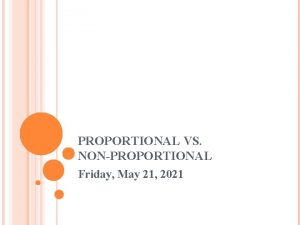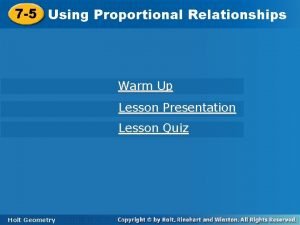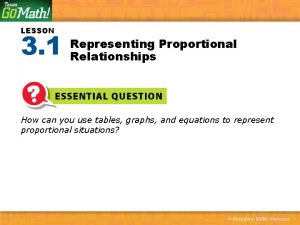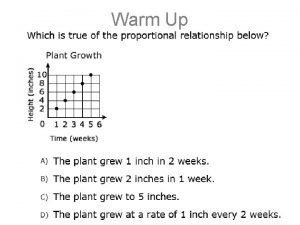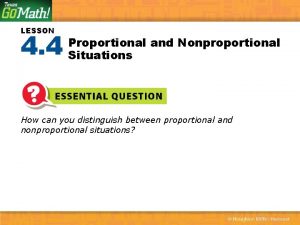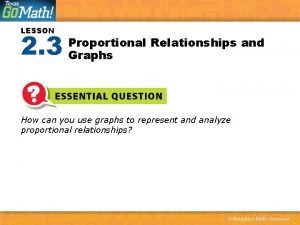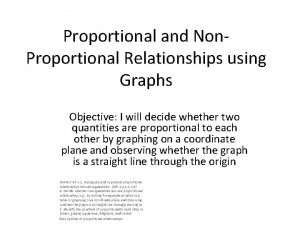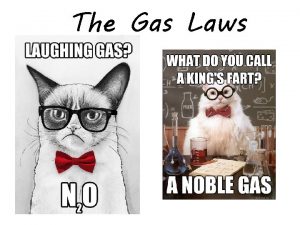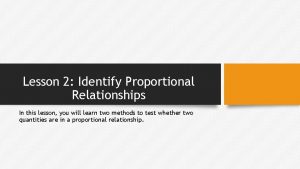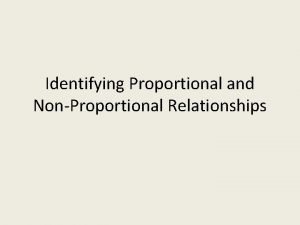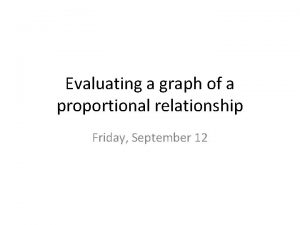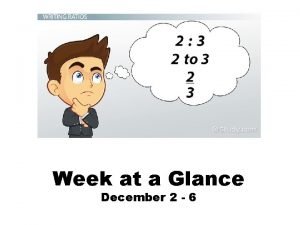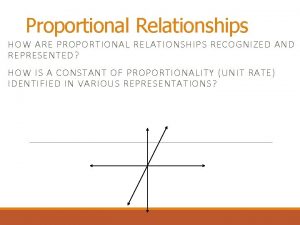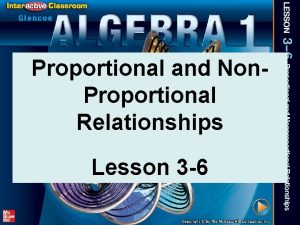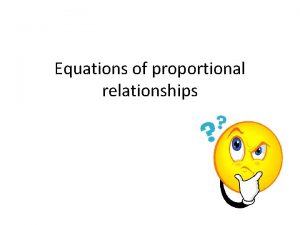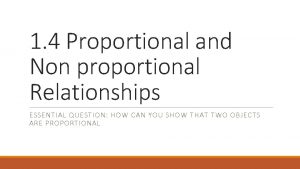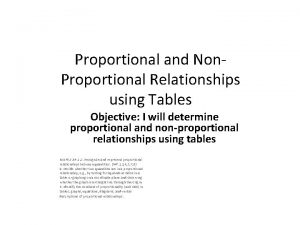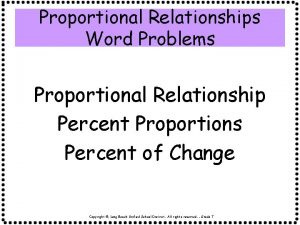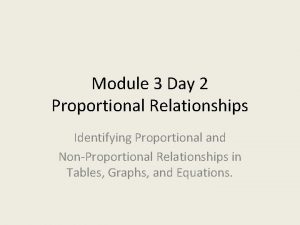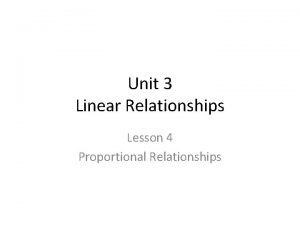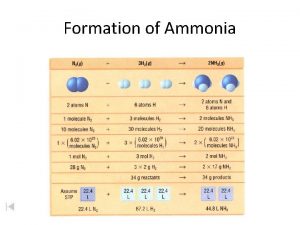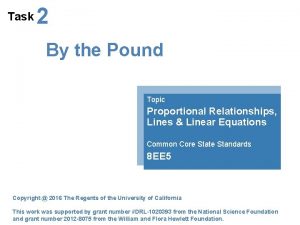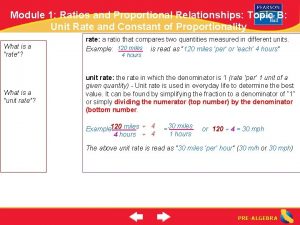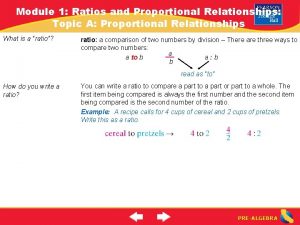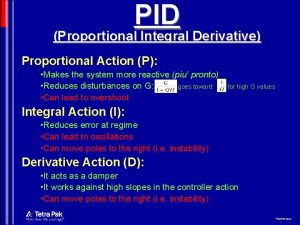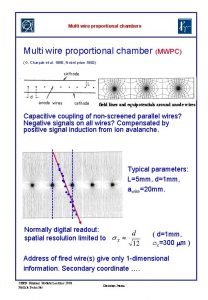Topic A Proportional Relationships Lesson 2 Proportional Relationships

























- Slides: 25

Topic A: Proportional Relationships Lesson 2 Proportional Relationships

Welcome! • Hello! My name is Mrs. Andersen, I will be your new teacher for the year. Please take a seat at your same seat as with Mr. Kemble, and start on your classroom inventory.

Classroom Expectations • BRUIN way • Raise your hand to speak • Raise your hand for permission to leave your seat • Come prepared-Pencil, or pen, notebook and be ready to learn • Treat each other and the classroom with respect

Classroom Website • mrsandersenbms. weebly. com

LEARNING TARGET Lesson 2: Proportional Relationships – Day 1 Today I can identify the constant of proportionality (k) and write an equation from a table in the form y = kx. STANDARDS 7. RP. 2 b Identify the constant of proportionality (unit rate) in tables, graphs, equations, diagrams, and verbal descriptions of proportional relationships. 7. RP. c Represent proportional relationships by equations. KEY VOCABULARY Proportional Constant of Proportionality AGENDA • (10 min) Review Key Vocabulary • (5 min) Example 1: Pay by the Ounce Frozen Yogurt • (10 min) Discussion • (10 min) Write an Equation • (5 min) Example 2: A Cooking Cheat Sheet! • (10 min) Discussion • (10 min) Example 2 (Continued)… • (5 min) Exit Ticket • (20 -30 min) Online Practice

Review Key Vocabulary • Proportional – when two quantities that simplify to the same ratio. • Constant – a quantity having a value that does not change or vary. • Constant of Proportionality - a constant value of the ratio of two proportional quantities.

Example 1: Pay by the Ounce Frozen Yogurt A new self-serve frozen yogurt store opened this summer that sells its yogurt at a price based upon the total weight of the yogurt and its toppings in a dish. Each member of Isabelle’s family weighed their dish and this is what they found. Weight (ounces) 12. 5 10 5 8 Cost ($) 5 4 2 3. 20

Discussion 1. Does everyone pay the same cost per ounce? How do you know? 2. Isabelle’s brother takes an extra-long time to create his dish. When he puts it on the scale, it weighs 15 ounces. If everyone pays the same rate in this store, how much will his dish cost? How did you calculate this cost? 3. What happens if you don’t serve yourself any yogurt or toppings, how much do you pay?

Write an Equation Weight (ounces) 12. 5 10 5 8 Cost ($) 5 4 2 3. 20 For any measure x, how do we find y?

Example 2: A Cooking Cheat Sheet! In the back of a recipe book, a diagram provides easy conversions to use while cooking.

Discussion 1. What does the diagram tell us? 2. Is the number of ounces proportional to the number of cups? How do you know? 3. Is there another way to represent this same information?

A Cooking Cheat Sheet! (Continued…) Cups (x) 0 ½ 1 1½ 2 4 5 8 Ounces (y) 0 4 8 12 16 ? ? ? 1. For any number of cups x, how do we find the number of ounces, y? 2. If we want to verify our equation, which �� and �� values can we use to see if it is true? How do you know?

1. Explain how we found the constant of proportionality? 2. Explain how we used the constant of proportionality to find missing values in the table.

Exercise 1: Calories Burned During Jose’s physical education class today, students visited activity stations. Next to each station was a chart depicting how many Calories (on average) would be burned by completing the activity.

Discussion 1. Is the number of calories burned proportional to time? How do you know? 2. If Jose jumped rope for 6. 5 minutes, how many calories would he expect to burn?

Example 3: Summer Job Alex spent the summer helping out at his family’s business. He was hoping to earn enough money to buy a new $220 gaming system by the end of the summer. Halfway through the summer, after working for 4 weeks, he had earned $112. Alex wonders, “If I continue to work and earn money at this rate, will I have enough money to buy the gaming system by the end of the summer? ” To check his assumption, he decided to make a table. He entered his total money earned at the end of week 1 and his total money earned at the end of Week 4. Week Total Earnings 0 1 $28 2 3 4 $112 5 6 7 8

Discussion 1. How much do you think Alex earned by the end of 2 weeks? 2. How will a table help us to check Alex’s prediction? 3. Where did the two given pairs of data come from? 4. Is this reasonable? 5. What other pair could we complete fairly easily? 6. How will we find out his earnings after 2 weeks? 3 weeks?

Partner Work 1. Work with a partner to answer Alex’s question. 2. Are Alex’s total earning proportional to the number of weeks he worked? How do you know.

Exit Ticket – Day 2 1. How did you determine if Alex’s earning was proportional to the number of weeks he worked? 2. What is a situation where earning is not proportional to the number of weeks worked?

LEARNING TARGET Lesson 2: Proportional Relationships – Day 3 Today I can determine if two quantities are proportional from a word problem. STANDARDS 7. RP. 2 a Decide whether two quantities are in a proportional relationship, e. g. , by testing for equivalent ratios in a table or graphing on a coordinate plane and observing whether the graph is a straight line through the origin. KEY VOCABULARY Proportional Constant of Proportionality AGENDA • (10 min) Review Key Vocabulary • (15 min) Extension & Share Out • (20 min) Problem Set • (5 min) Lesson Summary • (20 -25 min) Lesson 2 – Quiz • (10 min) Grade & Correct • (5 min) Collect Class Data

Review Key Vocabulary • Proportional – when two quantities that simplify to the same ratio. • Constant – a quantity having a value that does not change or vary. • Constant of Proportionality - a constant value of the ratio of two proportional quantities.

Extension Ms. Albero decided to make juice to serve along with the pizza at the Student Government party. The directions said to mix 2 scoops of powdered drink mix with a half a gallon of water to make each pitcher of juice. One of Ms. Albero’s students said she will mix 8 scoops with 2 gallons of water to get 4 pitchers. How can you use the concept of proportion to decide whether the student is correct?

Problem Set 1 Point (Unsatisfactory) 2 Points (Partially Proficient) 3 Points (Proficient) A correct answer Missing or incorrect with some evidence answer and little answer but of reasoning or an evidence of some incorrect answer reasoning with substantial evidence 4 Points (Advanced) A correct answer supported by substantial evidence of solid reasoning

Lesson Summary 1. How do we know if two quantities are proportional to each other? 2. How can we recognize a proportional relationship when looking at a table or a set of ratios?

Lesson 2 - Quiz 1 Point (Unsatisfactory) 2 Points (Partially Proficient) 3 Points (Proficient) A correct answer Missing or incorrect with some evidence answer and little answer but of reasoning or an evidence of some incorrect answer reasoning with substantial evidence 4 Points (Advanced) A correct answer supported by substantial evidence of solid reasoning
 Proportional vs non proportional relationships
Proportional vs non proportional relationships 7-5 problem solving using proportional relationships
7-5 problem solving using proportional relationships 3-1 representing proportional relationships
3-1 representing proportional relationships Lesson 10 interpreting graphs of proportional relationships
Lesson 10 interpreting graphs of proportional relationships Lesson 4-4 proportional and nonproportional situations
Lesson 4-4 proportional and nonproportional situations Lesson 4 proportional and nonproportional relationships
Lesson 4 proportional and nonproportional relationships Lesson 2 proportional relationships
Lesson 2 proportional relationships Non proportional table
Non proportional table Inversely proportional
Inversely proportional Identifying graphs worksheet
Identifying graphs worksheet Indirectly proportional
Indirectly proportional Proportion relationship
Proportion relationship Clincher ideas
Clincher ideas /topic/ down
/topic/ down To find the height h of a dinosaur in a museum
To find the height h of a dinosaur in a museum Stoichiometry mole island diagram
Stoichiometry mole island diagram How to find proportional relationship on a graph
How to find proportional relationship on a graph 7-5 using proportional relationships
7-5 using proportional relationships Proportional and nonproportional relationships
Proportional and nonproportional relationships Unit rate triangle
Unit rate triangle Identify proportional relationships
Identify proportional relationships Identifying proportional relationships in graphs worksheet
Identifying proportional relationships in graphs worksheet Proportional and nonproportional relationships answer key
Proportional and nonproportional relationships answer key Whats a proportional relationship
Whats a proportional relationship Graphing proportional relationships quiz
Graphing proportional relationships quiz Math antics proportional relationships
Math antics proportional relationships
